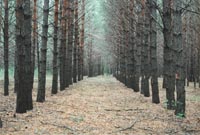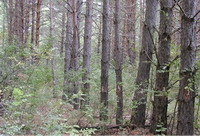


 |
|
 |
|
Rus/Eng
|
|
||||||||||||
|
"Хвойные бореальной зоны" 2010г., №1-2, с. 50 - 57 УДК 582.475.4: 575.86МЕЖВИДОВАЯ ГИБРИДИЗАЦИЯ КАК ФАКТОР СЕТЧАТОЙ ЭВОЛЮЦИИ 5-ХВОЙНЫХ СОСЕН СЕВЕРНОЙ И ВОСТОЧНОЙ АЗИИ С.Н. Горошкевич1, Е.А. Петрова1, Г.В. Васильева1, Д.В. Политов2, А.Г. Попов1 О.Г. Бендер1, М.М. Белоконь2, О.В. Хуторной1, Ю.С. Белоконь2 1Институт мониторинга климатических и экологических систем СО РАН 634021 Томск, Академический пр., 10/3; е-mail: gorosh@imces.ru 2Институт общей генетики им. Н.И. Вавилова РАН, Москва С использованием традиционных (анатомо-морфологических) и современных (молекулярно-генетических) признаков проанализирована структура разнообразия в группе 5-хвойных сосен Северной и Восточной Азии. P. pumila и P. koraiensis по комплексу признаков занимают промежуточное положение между P. sibirica и P. parviflora, P. sibirica и P. Armandii, соответственно. Это позволяет предположить, что кедровые сосны (подсекция Cembrae) не являются естественной группой видов монофилетического происхождения, а вместе с некоторыми видами веймутовых (подсекция Strobi) образуют единую филогенетическую систему, сформировавшуюся в результате сетчатой эволюции: чередования климатически обусловленных циклов дивергенции видов и их естественной гибридизации. Современные процессы ге-нетического взаимодействия между видами изучены на примере P. sibirica и P. pumila в Забайкалье. Естественные гибриды в количестве до 5 шт./га встречаются по всей гибридной зоне (Хамар-Дабан, Хентей-Чикойское и Становое нагорья). Большинство гибридов по комплексу морфологических и физиологических признаков занимают строго промежуточное положение между видами. Из-за некоторой разбалансировки морфофизиологических адаптаций гибриды имеют пониженную устойчивость по сравнению с видами, но они способны к активному вегетативному размножению и занимают относительно свободную экологическую нишу во втором ярусе древостоя. По фертильности гибриды существенно (в 2-3 раза) уступают родительским видам, но (по результатам изоэнзимного анализа), в семенах гибридов доля зародышей, возникших от опыления гибридной пыльцой, на порядок выше, чем ее доля в общем пыльцевом пуле популяции. Достаточная жизнеспособность и фертильность естественных гибридов между P. sibirica и P. pumila, а также их предрасположенность к скрещиванию между собой, позволяет рассматривать их как перспективное эволюционное но-вообразование, возможно, «зародыш» нового вида. Ключевые слова: пятихвойные сосны, гибридизация, сетчатая эволюция Diversity structure of 5-needles pines from North and East Asia was studied with classical (anatomical, morphological) and current (molecular genetic) traits. By set of traits P. pumila and P. koraiensis was intermediate between P. sibirica and P. parviflora, P. sibirica and P. Armandii, respectively. It’s allow to suggest that stone pines (subsection Cembrae) are not natural group of species having monophyletic origin but they with some species from white pines (subsection Strobi) form integrated phylogenetic system resulted from reticulate evolution, namely alternation divergence caused by climate and interspecific hybridization. Current genetic interaction between species was studied by way of example P. sibirica and P. pumila in the Transbaikalia. Natural hybrids (up to 5 individuals per ha) are occurred throughout the hybrid zone (Hamar-Daban, Hentey-Chikoyskoe highland Stanove highland). By set of morphological and physiological traits the most of hybrids are intermediate between species. Due to some unbalancing of morphological and physiological adaptation hybrids have reduced resistance in comparison with species, but they are able to active vegetative propagation and occupy relatively free ecological niche in the second tree layer. Fertility of hybrids is significantly less (in the 2-3 times) than that of parental species, but portion of hybrid embryo resulted from pollination by hybrid pollen is higher than portion of hybrid pollen in the total pollen pool of population. Sufficient viability and fertility of natural hybrids between P. sibirica and P. pumila and their aptitude to cross among themselves permit to consider hybrids as a promising evolutional new formation that can result in novel species. Key words: 5-needle pine, hybridization, reticulate evolution БИБЛИОГРАФИЧЕСКИЙ СПИСОК
|
|||||||||||